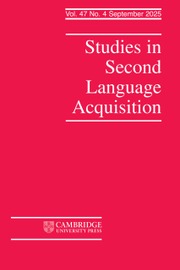Article contents
THE ROBUSTNESS OF CRITICAL PERIOD EFFECTS IN SECOND LANGUAGEACQUISITION
Published online by Cambridge University Press: 28 January 2003
Abstract
This study was designed to test the Fundamental Difference Hypothesis (Bley-Vroman,1988), which states that, whereas children are known to learn language almost completelythrough (implicit) domain-specific mechanisms, adults have largely lost the ability to learn alanguage without reflecting on its structure and have to use alternative mechanisms, drawingespecially on their problem-solving capacities, to learn a second language. The hypothesisimplies that only adults with a high level of verbal analytical ability will reach near-nativecompetence in their second language, but that this ability will not be a significant predictor ofsuccess for childhood second language acquisition. A study with 57 adult Hungarian-speakingimmigrants confirmed the hypothesis in the sense that very few adult immigrants scored withinthe range of child arrivals on a grammaticality judgment test, and that the few who did had highlevels of verbal analytical ability; this ability was not a significant predictor for childhoodarrivals. This study replicates the findings of Johnson and Newport (1989) and provides anexplanation for the apparent exceptions in their study. These findings lead to areconceptualization of the Critical Period Hypothesis: If the scope of this hypothesis is limited toimplicit learning mechanisms, then it appears that there may be no exceptions to the age effectsthat the hypothesis seeks to explain.
Information
- Type
- Research Article
- Information
- Copyright
- 2000 Cambridge University Press

